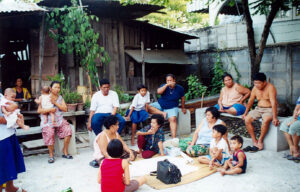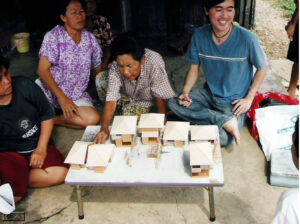By Minori Matsusawa
Introduction
Bangkok, the capital city of Thailand, has experienced rapid growth in the last decades. The city now has a population of approximately ten million people, and the sprawl to the adjacent suburban region contributes further to the growth of the metropolitan region (Sotomayor, 2017). Like many other mega-cities, Bangkok struggles to address the challenges of informal settlements, the threats of eviction, and inadequate public service provision. It is estimated that 300,000 households live in 1,500 informal communities across the Bangkok metropolitan region (Sotomayor, 2017). In the globalizing and growing neoliberal economy, the increase in land prices driven by private interests threatens the informal community and their land security.

Khlong Toei, the largest and oldest slum of Bangkok against high-rise skyline. See Source Here: South China Morning Post.

Life on a street of Khlong Toei. School children buying food from an ambulant vendor. See Source Here: South China Morning Post.
After a decade of unsuccessful attempts at slum upgrading and housing programs, the Baan Mankong (“secure housing”) initiative was launched in 2003 to address housing issues through a holistic community development process, while tackling structural issues of poverty, governance, and political participation. The main actor in this program is the Community Organization Development Institute (CODI), a quasi-governmental organization developed to address housing issues for the urban poor in Thailand (Sotomayor, 2017). CODI formed a joint committee to provide a platform for collaboration between the informal settlers, local governments, professionals, universities and NGOs. Within the framework set up by CODI, the members of informal communities and their networks are responsible for the negotiation for land tenure, the collective process of developing a long-term, comprehensive plan for their community, as well as collective fund (savings) to finance the project. CODI helps the process by nurturing the collaboration between stakeholders and by channeling the government funds once the community develops a housing and community development plan for themselves (CODI).

Informal settlement residents gathering to discuss their community. See Source Here.
Analysis
Unlike insurgent planning practices that develop from bottom-up, grassroots social movements, the Baan Mankong initiative operates within the sphere of “invited spaces” for planning, or “sanctioned spaces for participation” provided by formal entities or authorities (Miraftab, 2009). In Baan Mankong projects, CODI creates a platform for the inclusion of informal settlers in the planning process. One of the criticisms of planning initiatives that promote themselves as ‘inclusive’ or ‘participatory’ is that the perception of inclusion is used to buttress hegemonic power in neoliberal governance and that participation does not lead to equity (Miraftab, 2009). However, the Baan Mankong initiative does not diminish the political influence of the participating community members, but rather provides opportunities for counter-hegemonic practices that go against the stabilizing power of social and political hierarchy.
Although CODI is a public agency, the planners involved in the projects are outside of government branches that control land and development. In addition, CODI is a special-purpose body dedicated to supporting informal communities without pressures to attain economic profits. This allows CODI planners to facilitate communication and negotiations on behalf of community members without being constrained by political or bureaucratic expectations, or by profit requirements from private entities. In addition, planners serve as facilitators and educators in the planning process in order to help communities navigate the legal and bureaucratic processes (Sotomayor, 2017). This allows planners and local citizens to equally engage in the improvement of life conditions through a common understanding that “place-making is everyone’s job” (Friedmann, 2010). While planners have the formal knowledge and training to with state authorities, they lack understanding about the community from the local citizens’ perspectives. Meanwhile, local people often feel discouraged or disqualified to speak up in planning processes because they do not speak the same technical language as planners or local authorities (Friedmann, 2010). By presenting the members of informal settlements with their responsibilities and rights to plan for their communities, all the actors in the planning process can engage in a meaningful dialogue in a search for solutions that best accommodate the needs of the residents.

The actors and the structure of the Baan Mankong initiative. See Source Here.
Relationships forged through the Baan Mankong initiative create new “political openings and opportunities” and encourage increased political participation, such as involvement in campaigns and demonstrations to protect informal settlements from eviction and natural disaster risks (Sotomayor, 2017). This makes Baan Mankong a case where the planning practices in the formally prescribed ‘invited’ space to extend to further grassroots, insurgent planning actions in the “invented” spaces of citizenship (Miraftab, 2009).
While the financial support from the government is channeled through a centralized system via CODI, the planning process is decentralized, and the outcome varies between participating communities. Through the planning program, the communities organize themselves with the help of CODI to produce knowledge about themselves, negotiate and claim their rights, and then make decisions about their neighborhood either through housing projects or through relocation (Sotomayor, 2017). The network of informal community groups formed by the Baan Mankong framework allows for sharing of knowledge, information, and best practices to strengthen their negotiating power (Sotomayor, 2017).

Residents mapping their community. See Source Here.
Implications
The Baan Mankong shows that a “commitment to advance transformational goals can also be found at higher scales of political leverage beyond the grassroots level” (Sotomayor, 2017, 275). It also shows that planners can play a bridging role between the state and informal communities, and that they can help mobilize government resources to advance the interest of the marginalized community. The Baan Mankong initiative nurtures self-governance through collective action and coordination among various actors. Such self-governance mechanisms are better positioned to address the community’s problems and challenges as they can adapt to changing circumstances more easily than conventional spatial planning guided by normative rules. These community-driven initiatives are effective “particularly when support is received from the city authorities” (Nunbogua, 2018, p. 39). Planners can engage in this new form of governance and planning as facilitators to connect the community with external actors, thus helping balance conflicting needs to accomplish meaningful urban transformation (Nunbogua, 2018).
The Baan Mankong initiative and its participatory approach can be applied to cities facing similar challenges because of its sensitivity to heterogeneous social, political, and geographic circumstances, as well as its reliance on locally produced knowledge and networks. This initiative thus reflects a “southeastern” perspective that recognizes the diverse and dynamic nature of urban societies and existence of various structural systems, as opposed to the dominant global northwestern approach that seeks to enforce ‘universal’ knowledge, conditions, and norms specific to societies in Western Europe and North America (Yiftachel, 2020). In fact, CODI has helped community groups in 18 other countries in Asia, including Cambodia, Laos, Indonesia, and Myanmar, launch citywide housing development processes, while exchanging support and sharing ideas with various organizations and groups in these areas (CODI). These cross-referencing and borrowing practices enable communities to imagine their future beyond postcolonial subjectivity or the singular model of urban form celebrated in the Global North and in the West. The dominant practice of urban modeling attempts to recreate a replica of Western global cities such as New York, London, or Paris. However, the inter-referencing practice of “worlding” also looks at non-western examples of global cities, and experiments by borrowing some essence or components from various urban formations. Through this process of multiple referencing, urban actors can imagine a global city of the future that reflects multiple cultural norms (Ong, 2011).

Residents working with a CODI architect. See Source here

Showcase of the new community plan. See Source Here.
